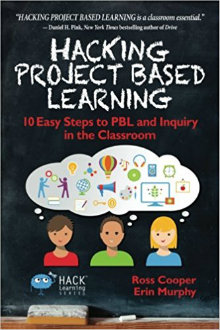10 Easy Class Hacks Boost PBL and Inquiry
Hacking Project Based Learning: 10 Easy Steps to PBL and Inquiry in the Classroom
By Ross Cooper and Erin Murphy
(Times 10 Publications, 2016 – Learn more)

Each day I have the opportunity to teach in a PBL (project-based learning) setting. Our charter school has been in place for six years, so I am always eager to find innovative and practical ideas to enhance our program.
Hacking Project Based Learning is a guidebook of common sense ideas that are embedded in a PBL instructional perspective. This book simplifies PBL essentials into “10 hacks,” encouraging teachers to take a risk and safely try PBL.

“Many of these practices can be called on with or without PBL….The more we have familiarized ourselves with PBL, the more we have come to realize it is a series of best practices joined together.”
Each chapter in the book begins with:
- The Problem: Schools Kill Creativity
Earlier I mentioned that most ideas are strategies and approaches that all teachers should be using in the classroom. The key to the book is how it suggests a hack to solve everyday classroom problems. As you read each hack, you may tell yourself that these are simply good teaching practice. However, the authors add a twist on each of the hacks and directly tie it to PBL.
- The Hack: Develop a Space That Promotes Risk-Taking
“A successful PBL classroom relies on a culture of inquiry and creativity to ensure students engage in deeper learning driven by their curiosity. We develop this culture by: building relationships, fostering learner agency through physical environment, creating a resource-rich classroom, teaching students to ask questions, and promote risk-taking.”
I want to stand up and applaud these ideas because they are the foundation for a solid PBL program. This book may not be a complete guidebook on how to implement PBL, but each hack brings a classroom closer to an inquiry-based environment.
The 10 hacks also offer solutions to real-life situations in the classroom. One example is the lack of student engagement along with the struggle to work collaboratively in groups.
- Hack #2: Teach Collaborative Skills
- Hack #5: Students Need an Engaging Context for Their Work
“If we expect students to collaborate, we must teach them how.” The authors include a “blueprint for full implementation” which includes defining and modeling what collaboration looks like. The hack suggests students view videos of group collaboration and analyze group dynamics. What does collaboration look like, sound like, and feel like?
I agree with the authors when they write “consistent, continual feedback and practice related to collaboration is imperative.” An example of “the hack in action” suggests having a group of students begin their conversation while the rest of the class listens and observes. After a while, the teacher stops the group discussion and asks the class to reflect on the group’s conversation to create additional expectations and strategies. Real-life modeling moves collaboration to a deeper level.
A rich resource emphasizing student ownership
Hacking Project Based Learning explores additional areas including assessment, feedback, the use of mini-lessons, and the final publishing/presentation of projects. Each chapter is an easy read with practical ideas, hints and blueprints that could be used the next day.
I especially appreciate the strong emphasis on student ownership in each of the hacks. This guide is a rich resource from theory to application for teachers and administrators who are looking to begin implementing PBL in the classroom.
Sandy Wisneski is lead teacher at Catalyst Charter Middle School in Ripon, WI. She is the district Webmaster, tech mentor, and yearbook advisor, as well as IE mentor. Over the past 40+ years she obtained her masters in reading, became certified as a Flat Classroom Teacher, Common Sense Ambassador, and BrainPOP Certified Educator. She’s attended Honeywell Educators @ Space Academy and Honeywell Green Boot Camp in San Diego. Sandy enjoys challenging students to “take ownership” for their learning and to be effective digital citizens in the world. Follow her on Twitter @stampcat2 and at Stampcat2Technified Blog and CatalystChannelBlog.































Great post, Sandy! Let’s talk on Monday! I would love to put more PBL in my ELA classes! #ilovemycolleagues